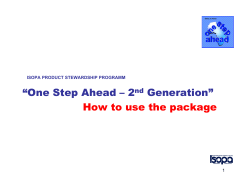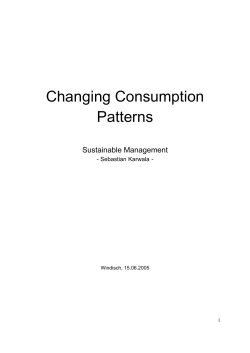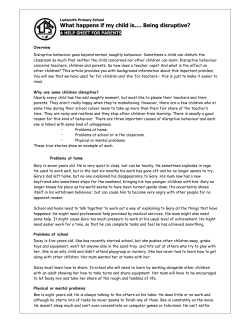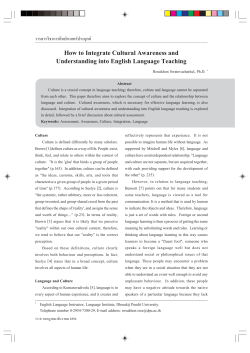
‘Cracking the toughest nut: How to turn behaviour change theory into practice.’
‘Cracking the toughest nut: How to turn behaviour change theory into practice.’ IEA DSM TASK XXIV Closing the Loop Behaviour Change in DSM: From Theory to Practice Nick Potter: re-be.com BEhavE conference, Helsinki Finland, September 20-21 Dr Sea Rotmann (Operating Agent, Task XXIV) Who are we? Ruth Mourik (Duneworks, NL) ruth.mourik@duneworks.nl Sea Rotmann (SEA, NZ) drsea@orcon.net.nz THEORY PRACTICE PhD in Science & Technology Studies 8 years working experience Energy Research Center NL (ECN) Lead EU behaviour change research projects CREATE ACCEPTANCE and CHANGING BEHAVIOUR Now working with DSOs, retailers, municipalities on smart grid/smart metering rollouts and pilots PhD in Environmental Impact Assessments 3 years working experience in sustainability implementation in major NZ Govt departments (10,000+ staff members) Strategic advice to NZ Ministry of Science and Innovation on demand side energy matters and research prioritisation and evaluation 4 years working on sustainable energy research policy, with focus o turning behaviour change theory into practice • • • • • • • Background to IEA DSM Implementing Agreement One of more than 40 co-operative energy technology programmes within the International Energy Agency (IEA). The DSM IA is an international collaboration of 15 countries. DSM offers solutions to problems such as load management, load shifting, energy efficiency, strategic conservation and related activities. The work is organised through a series of Tasks. Work is reported in publications. The IA is managed by an Executive Committee (ExCo). Each Task is funded by participating countries who contribute National Experts to support the Operating Agents. What is DSM? • • • Demand Side Management (DSM) generally refers to all changes that originate from the demand (energy user) side. Reduce the demand for energy (conservation) and shift demand from peak periods to off-peak periods (load-management). Goal is to achieve large scale energy efficiency improvements usually by deployment of improved technologies. 4 Pics via: tatapower.com, jcwinnie.biz, Guardian.co.uk, Treehugger.com, What is Behaviour Change? • • It is estimated that up to 30% of energy demand is locked in the so-called ‘behavioural wedge’. This ‘wedge’ includes people’s energy-using habits (what they do), as well as their purchasing decisions of energy (in)efficient technologies (what they do it with) Demand shifting Demand reduction Demand shifting Demand reduction Intentional or efficiency behaviours Routine or conservation behaviours 5 We believe that: • • • The ‘market failure’ of energy efficiency is often due to the vagaries of human behaviour and choice, not a lack of energy efficient or demand-managing technologies. Social norms are some of the most important drivers of human behaviour, and some of the most difficult to change. Better understanding of human behaviour in energy use is key to achieving a successful transition to a sustainable energy system. An important caveat • In this Task, a successful behaviour change outcome results in improved energy use by households and businesses. This does not necessarily focus solely on reduction in total energy use (although this is the medium to longterm goal), but on the most efficient and environmentally friendly use of energy to derive the services that underpin societal and economic wellbeing (eg comfort, mobility, entertainment, cleanliness, production etc). Premise for Task XXIV That the current energy efficiency gap (or ‘market failure’ of energy efficiency) results from: Homo sapiens sapiens ≠ Homo economicus overly technocratic approaches the limited transfer of best practice and good research to the policy domain the lack of meaningful monitoring and evaluation tools limited information tailored specifically to countries’ needs. 8 Pics via: apache.be, h2-economy.com, agu.org,, library.carlton Objective of Task XXIV 1. Creating and enabling an international expert network interacting with countries’ expert networks 2. Provide a helicopter overview of current behaviour change models, frameworks, disciplines, contexts, monitoring and evaluation metrics 3. Provide detailed assessments of case study applications focusing on participating/sponsoring countries’ needs (smart meters, SMEs, transport, building retrofits) 4. Create internationally validated monitoring and evaluation tool based on stakeholder needs for proving successful behaviour change outcomes 5. Break down silos, enable mutual learning on how to turn theory into practice 5Expert platform 1- Helicopter overview of models, frameworks, contexts, case studies and evaluation metrics 2- 3- 4- In depth analysis in areas of greatest need Evaluation tool for stakeholders Country-specific project ideas, action plans and pilot projects Objectives of Task XXIV 10 Pics via: theinnovativeeducator.blogspot.com, dreamstime.com, agu.org, lifesupplemented.org, rassutassu.com, change.comminit.com Some special features of Task XXIV 11 Pics via: sintef.no, jimsmarketingblog.com, techvert.com, storyfest.com, onegreenplanet.org, smh.com.au, core77.com Subtask 5 - Expert platform www.ieadsmtask24.ning.com Want to join? http://ieadsmtask24.ning.com/?xgi=5LLXb1UhqKzXNK 12 Learnings - Expert platform Really good in terms of invitations and organic, ongoing increase of expert members ~ OK in terms of engagement with discussions, groups, events etc X Insufficient in terms of data management There is still a widespread reluctance to use social media professionally, even in a ‘safe’, closed expert group like this. The most common reasons are likely: the time required to interact/engage; a ‘trust’ factor especially when not knowing the other members personally/professionally; not seeing the ‘point’ of social media; etc (see also Rotmann et al, 2011). Subtask I - Helicopter Overview There are many different behaviour change disciplines, models and frameworks, which often operate in silos. As a first step when moving towards an interdisciplinary model of better understanding behaviour change, we will present an inventory the diverse (sub)disciplines and models. Case studies will be provided to help understanding the benefits and limitations of applying different models to different contexts. Ultimately, we hope to provide participating countries with the ability to select relevant models that inform DSM initiatives focusing on particular topics of interest (detailed analysis in Subtask II). Subtask I - Example: Energy Cultures 1. Key questions: Name of this model Energy Cultures framework For which questions is this model of understanding suitable? What is ‘energy behaviour’? How do norms, practices and technologies influence one another to create habitual behaviour or behaviour change? What are the external factors influencing behaviour? What clusters of energy cultures are evident in a given population (households, businesses etc)? Can a nation be said to have a distinctive energy culture? What policy, market or other interventions might be most effective in achieving behaviour change? For which questions is this model of understanding unsuitable? The model is useful for considering systemic interactions, stasis and change, and particularly designed to support interdisciplinary studies. Systems thinking, lifestyles as symbolic communication, actor-network theory, habitus, socio-technical systems, everyday life, Lutzenhiser’s cultural model of household energy consumption (see Stephenson et al 2010 Energy Cultures: A framework for understanding energy behaviours, in Energy Policy for discussion) Complementarity with other models of understanding? 2. What does this model say about: Energy (DSM/consumption) Key units of analysis - The (role of the) individual The (role of) social context Role of technology Actors and institutions What behaviour is - Behavioural change processes Social change Distinctive consumption clusters are identifiable in the population, relating to their material culture and energy practices Both qualitative and quantitative data are suitable. We have used mixed methods including choice modelling, indepth interviews, statistical analysis of national survey n=2500, policy analysis, case studies, focus groups and social network analysis. For the individual (or household or firm), the model depicts the interacting influences of norms, technologies and practices in generating habit and/or change, as well as the influences of the social context within which the individual is situated. Technology is depicted as both a generator of norms and practices, but also a potential tool for significant shifts in these. Model aims to help identify what specific policy tools and/or market actions support change to norms, technologies and/or practices Behaviour is the interactions between norms, material culture and practices Seeks to identify what specific factors will support behaviour change, both for given energy culture clusters and for households generally. Also what drives change over time? E.g. How do energy behaviours develop in childhood? How does change in one area have roll-on effects in other areas? How does behaviour alter following significant shifts in material culture (e.g. moving home). At a societal level, how do energy cultures alter over time? How and why do the energy cultures of different nations differ? Relevant conditions/factors affecting behaviour change Drivers, attractors, choosing, enabling. Preference for attributes of new technologies. Energy culture clusters, stage of life Power of social networks and personalised information. Policy settings, social marketing, retailers and installers of energy technologies. Potential of (policy) interventions to encourage behavioural change Premise of model is to help identify what interventions will achieve change most effectively for what set of circumstances. Current intervention study is evaluating two different approaches to household behaviour change, using both qual and quant methods to evaluate. Monitoring and evaluation Subtask I - Example: Energy Cultures (cont’d) 3. What are the strengths of this model? (e.g. in terms of providing explanation, insight, a novel perspective; in terms of providing ideas for intervention; being action oriented or not; grounded in theory; grounded in empirical work) Model offers a novel perspective for thinking about energy behaviour in an integrated way. It is applicable at different scales (one household to nation); applies in different contexts (households, businesses and even nonenergy contexts) and deals with heterogeneity of situations. Useful as basis for design of interdisciplinary research and integrating findings from different sources. Gives insights into where effort is best placed for interventions to achieve behaviour change. Draws from several theoretical perspectives. 4. What are the weaknesses of this model? (e.g. in terms of providing explanation, insight, a novel perspective; in terms of providing ideas for intervention; being action oriented or not; grounded in theory; grounded in empirical work) 5. Additional comments (e.g. on how this model can be made practicable for practitioners, policy makers; in case this model addresses other topics than energy, how it still bears relevance to energy DSM) It is a theoretical framework rather than an explanatory theory of behaviour. Model has been used & tested in New Zealand work since 2010 and we are aware of it being used elsewhere, but is still relatively new - to date (Aug 2012) it has 15 citations. Model has also been applied (by others) to changing behaviour in relation to greenhouse gas emissions. Subtask II - Case studies Name of person who submitted this case study - year, researchers, references, main topic - (infrastructure, political, technological, cultural, social, economic, psychological, geographical, historical etc; point out country-specific issues pertaining to context influences) Model of understanding used - key units of analysis; main question; method Monitoring and evaluation metrics used - definitions of success; effectiveness, efficiency – criteria for evaluation Indicators, qualitative? Quantitative? Limitations of this evaluation ? Main outcomes: findings and conclusions - In terms of the case outcome (e.g. success or not of the DSM practice; effectiveness & efficiency; other...) Lessons learned (bullet point format) - with regard to the model of understanding used; with regard to behavioural change processes; with regard to measuring behavioural change; etc. Success - according to whom? Based on what outcome? Case study Contact details of person in charge/in the know Publications/ reports/ weblinks Summary (max 1 page) Key words, tags Behavioural change investigated (routine/habit, investment/purchasing) What was the case (unit of analysis) Geographical scope Context particularities Main focus/hypothesis Relevance for the IEA task Does it cover the broad areas of smart metering, transport, SMEs or building renovations? Strengths of the study Weaknesses of the study Additional comments - e.g. follow-ups? 4 overarching themes SMART METERING BUILDING RETROFITS Pics via: greensavingsco.com, fxgj.net, smebank.com.my SMEs 18 4 overarching themes: HOUSEHOLDS EFFICIENCY BEHAVIOUR $$$ once-off large impacts intended routine cheap/free habitual small, cumulative impacts BUILDINGS CONSERVATION BEHAVIOUR 19 TRANSPORT 4 overarching themes: SMEs EFFICIENCY BEHAVIOUR BUILDINGS CONSERVATION BEHAVIOUR $$$ once-off large impacts intended routine cheap/free habitual small, cumulative impacts 20 TRANSPORT Subtask III- Evaluation WHAT IS A SUCCESSFUL LONG-TERM BEHAVIOUR CHANGE OUTCOME TO YOU? 21 Subtask IV: Country-specific recommendations 22 And remember: ‘The difference between theory and practice is that in theory it’s much easier than in practice!’ IEA DSM TASK XXIV Closing the Loop Behaviour Change in DSM: From Theory to Practice Nick Potter: re-be.com BEhavE conference, Helsinki Finland, September 20-21
© Copyright 2025














